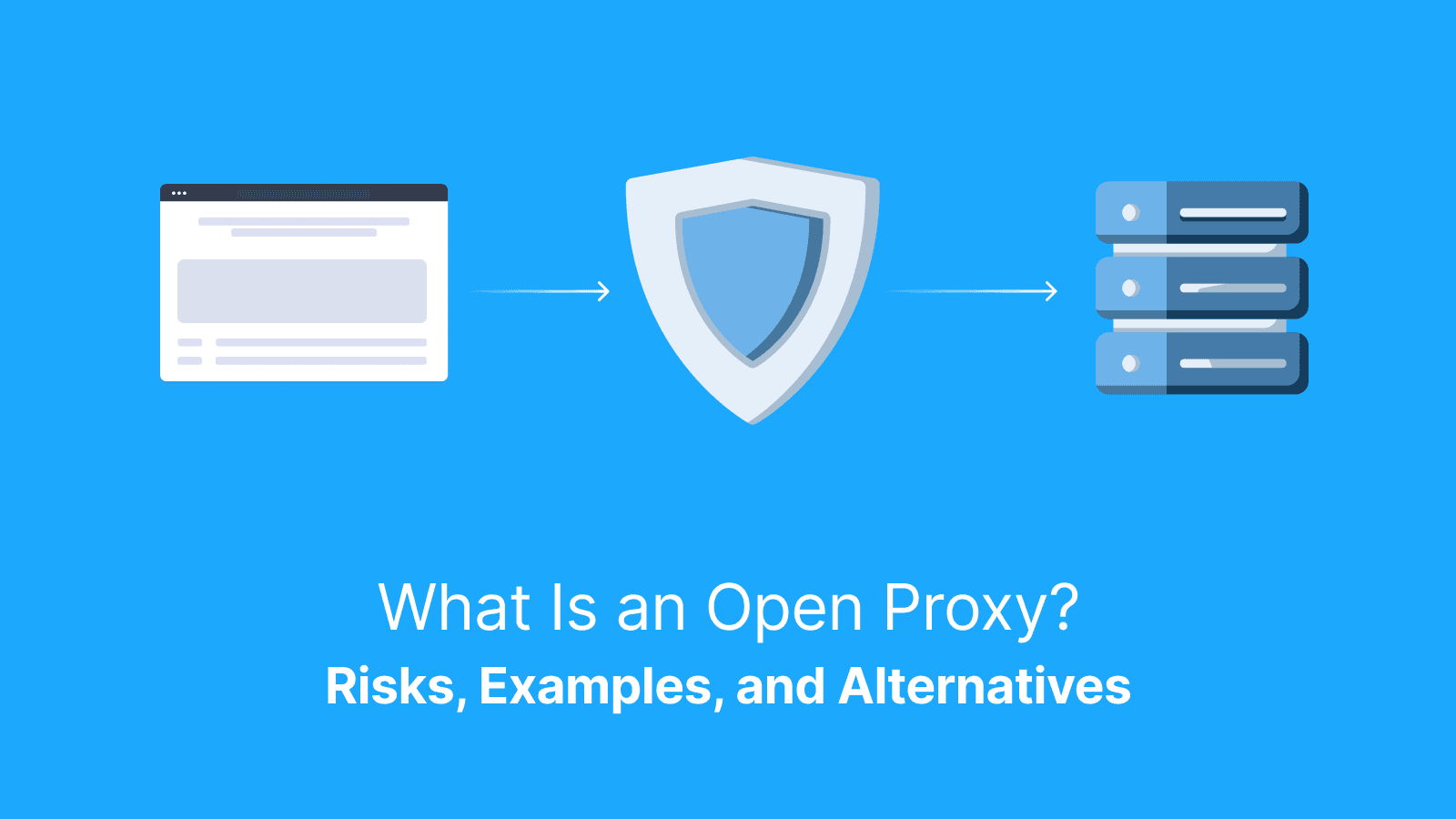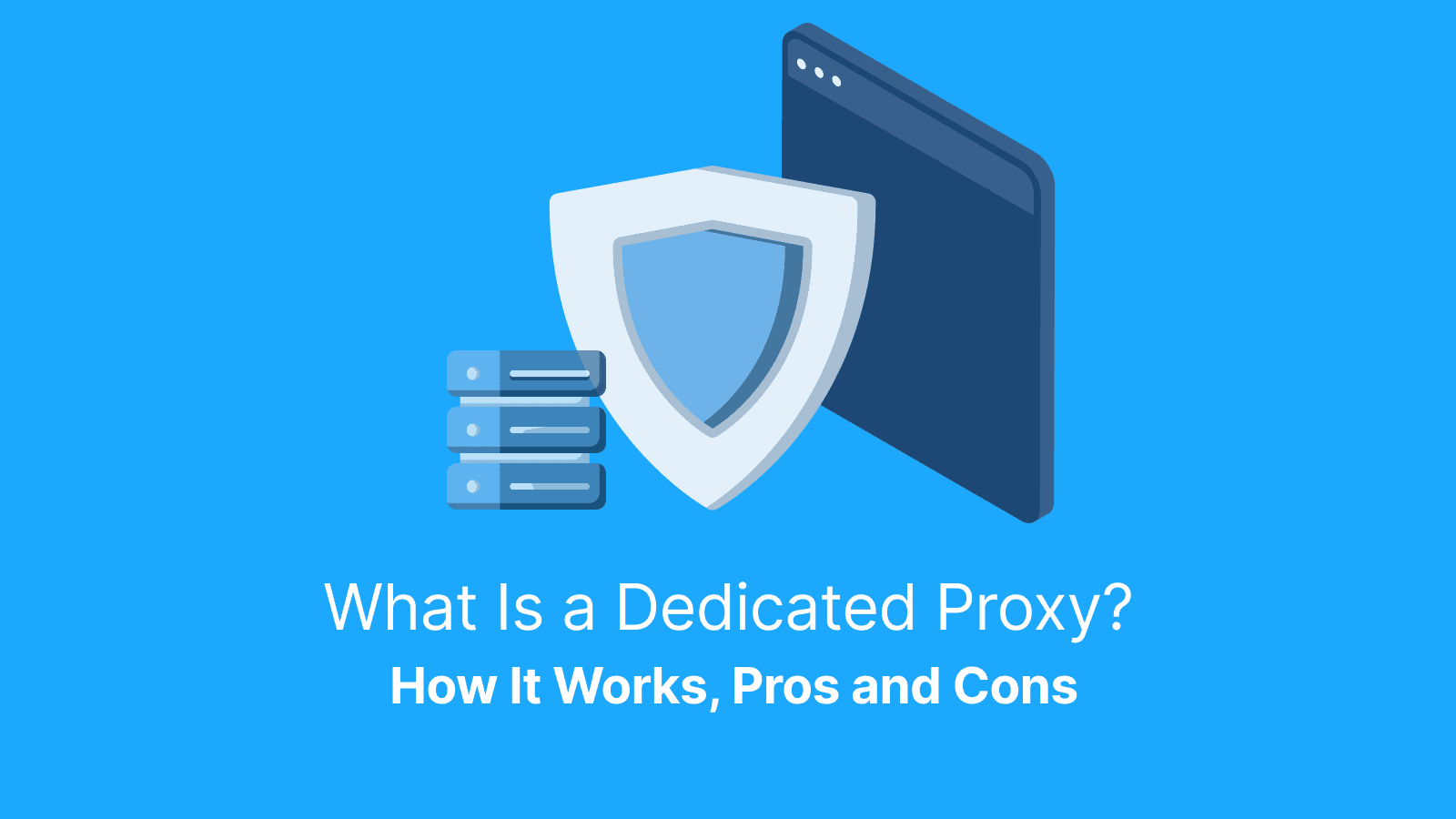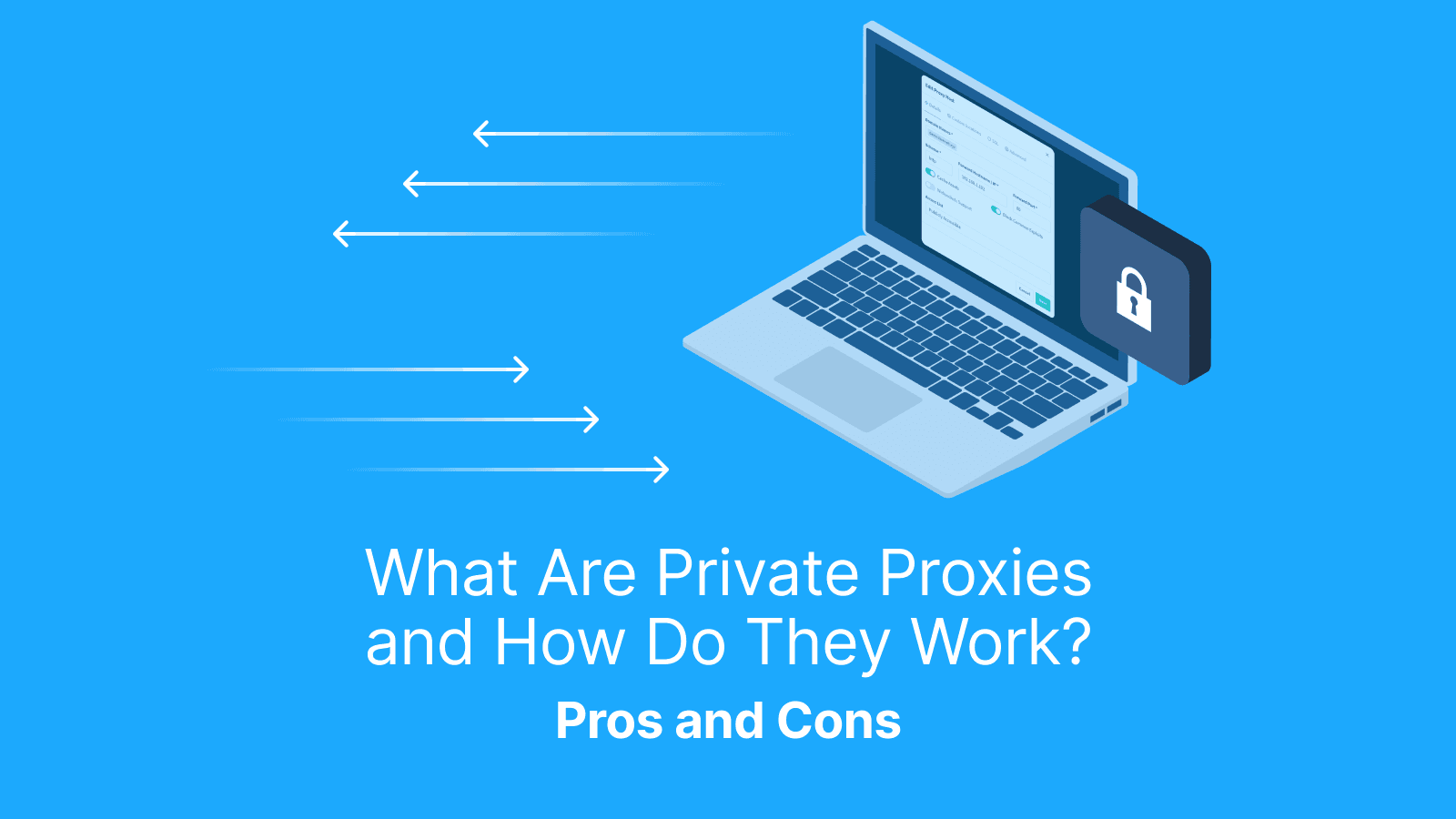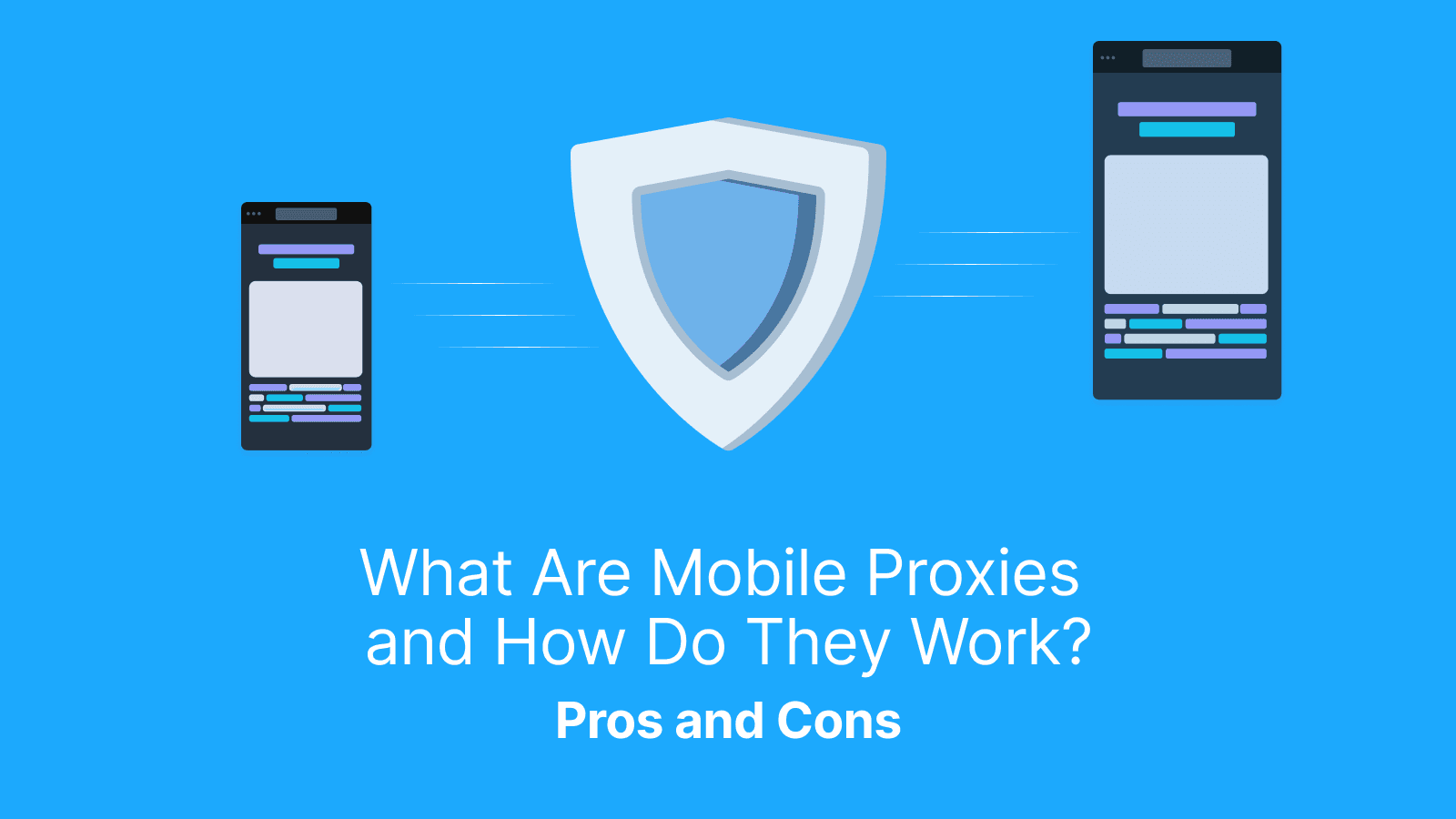An open proxy is a server that anyone can use on the internet without authentication. You may encounter the term when trying to log into a site while receiving a block message like “The IP address you are using has been flagged as an open proxy” (Instagram’s open proxy error message), or when using “free proxy” lists that deliver inconsistent results.
In this article, we’ll explain what an open proxy is, how platforms detect and flag them, the risks they pose, common abuse patterns, as well as some Instagram-specific issues. We’ll also cover how to verify your device has become an open proxy, safer alternatives such as residential, ISP, and datacenter proxies, as well as how to choose a provider.
What is an Open Proxy?
Open proxies arise from misconfiguration, deliberate exposure, or compromised hosts controlled by malware/botnets. Because anyone can use the same IP, open proxies are quickly abused, end up on reputation blocklists, and are widely banned by major platforms.
By contrast, authenticated proxies restrict access with credentials, making them controllable, accountable, and less likely to be poisoned by abusive traffic.
Open vs. Closed (Secured) Proxies
Closed proxies require login credentials, enforce usage limits, and operate under acceptable–use terms. Open proxies accept connections from anyone, making them unsafe and unstable.
The “free” label often associated with open proxies means the IP is shared among spammers, scrapers, and unsuspecting users. If one user misbehaves, the IP becomes tainted and blocked, leaving everyone else with connection failures.
Why are Open Proxies Risky?
Using an open proxy carries several risks:
- Most major platforms block connections outright: Traffic from open-proxy IPs is frequently challenged with CAPTCHA, 403/429 errors, or even temporary bans.
- You could face legal or contractual exposure: If abusive activity originates from your IP, you may be held responsible under platform ToS or even local law.
- Your IP may be linked to abusive activity: Since open proxies are abused by spammers and fraudsters, your address can end up on reputation blocklists.
- Your traffic can be intercepted: Open proxies can observe and modify HTTP traffic and log HTTPS metadata. While decrypting HTTPS content requires extra compromise (like certificate installation), the risk of exposure remains.
- Unstable and poor performance: Open proxies rarely offer consistent speeds, making them unreliable for serious tasks.
Performance is also unstable, with frequent timeouts or slowdowns, and fraud prevention systems often apply stricter scrutiny. In short, open proxies create more problems than they solve.
What Abuse Patterns are Common?
Attackers frequently use open proxies for:
- Credential stuffing (automatic login attempts): Attackers run bulk username/password combinations through open proxies to avoid detection.
- Click-abuse campaigns: Fraudsters generate fake ad clicks, draining advertiser budgets while hiding their true location.
- Large-scale scraping: Bots harvest product data, prices, or content at scale, using open proxies to spread load and avoid bans.
- Spam email relays: Misconfigured open proxies can be abused to send spam, leading to entire IP ranges being blacklisted.
- Fraud runs: Criminals process stolen cards or accounts through open proxies to obscure their tracks.
For ordinary users, this translates into failed logins, HTTP 403 or 429 errors, constant captchas, and rejected purchases. Because open proxies attract malicious traffic, even legitimate browsing gets caught in the fallout.
How do Platforms Flag “Open Proxy” IPs?
Platforms rely on multiple signals such as behavioral patterns, port/tunneling activity, reputation lists, and sometimes active checks. Reverse DNS may provide hints, but it is generally a weak signal.
While false positives happen – for example, public WI-FI networks or Shared egress (e.g., public Wi-Fi, enterprise NAT, VPN exits) can trigger false positives; CGNAT can cause crowding signals but isn’t usually an ‘open proxy.
Can Your Device Become an “Open Proxy” by Accident?
Yes. Some free VPNs, "accelerator" apps, or ad-supported extensions quietly conscript your device into a peer-to-peer proxy network. In those cases, your home IP behaves like an open proxy to others. This can trigger bans or strange traffic linked back to your connection.
To avoid this, uninstall dubious apps, audit browser extensions, check browser/system proxy settings in the OS, and check router/OS for UPnP or unexpected port-forwarding.
How Does an Open Proxy Compare to Other Proxy Types?
When comparing open proxies to other proxy types, the differences are clear. Open proxies lack control, stability, and compliance, while residential, ISP, and datacenter proxies are access-controlled, more reputable, and designed for reliable, long-term use. The table below highlights how each type stacks up.
| Proxy Type | Access Control | Reputation | Reliability | Compliance | Cost Profile |
|---|---|---|---|---|---|
| Open Proxies | None – anyone can use | Very poor – abused and blocked quickly | Highly unstable | None | Free but unsafe |
| Residential | Strict authentication | Strong – looks like normal users | High, but depends on pool | Enforced ToS, abuse handling | Higher cost |
| ISP Proxies | Access-controlled | Good – tied to ISP ASNs | Very stable, low latency | Clear sourcing, SLAs | Medium-high |
| Datacenter | Access-controlled | Moderate – some sites flag ranges | Very fast, scalable | Provider sets rules | Affordable |
Are “Anonymous/High-Anonymity” Proxies The Same as Open?
No. “Anonymous” or “high-anonymity” describes how much identifying information (like your IP) leaks in headers, whereas “open” refers to unrestricted access.
A proxy can be both anonymous and closed (safe and authenticated), or open and anonymous (anyone can use it). The risk comes from openness, not anonymity level.
What are Real-World Examples and Attack Patterns?
One common case is a botnet stringing together thousands of open proxies to brute-force accounts–spreading load so defenders can’t easily block a single origin.
Another involves spammers chaining open proxies to launder email traffic, causing entire IP ranges to get blacklisted.
These examples show how open proxies quickly degrade in reputation and harm even innocent users.
What Does Instagram’s “Open Proxy” Error Mean?
If Instagram tells you “The IP address you are using has been flagged as an open proxy”, it means the service has detected traffic patterns that look like open proxy abuse or found your IP on a blocklist.
Triggers can include:
- Home routers with peer-proxy features enabled: Device-level P2P VPN/proxy apps or extensions can conscript your IP; routers can expose services via UPnP/port-forwarding if misconfigured.
- Reassigned IPs with prior abuse history: ISPs often recycle IPs; if the previous owner used it for spam or fraud, you may inherit their bad reputation.
- Unsafe automation tools: Aggressive scripts or bots can generate traffic patterns that mimic proxy abuse, leading to blocks.
- Shady extensions: Certain browser add-ons secretly reroute your traffic, effectively turning your device into a proxy without your knowledge.
Instagram errs on the side of blocking to protect accounts from fraud.
How Do You Fix an Instagram Open-Proxy Flag Safely?
Start by uninstalling suspicious VPN/proxy apps and browser extensions. Then try power-cycling the router, releasing/renewing the DHCP lease, or requesting a new IP from your ISP; replacement is rarely needed
For legitimate multi-account business needs, switch to an access-controlled residential proxy from a reputable provider like Live Proxies. Unlike open proxies, which are unstable, abused by spammers, and easily blocked, residential proxies come from verified ISPs, have clean reputations, and are managed with strict access controls. This reduces the risk of bans and ensures long-term reliability. Avoid hacks or workarounds–they risk further flags.
Further reading: How to Use DuoPlus with Live Proxies: A Complete Guide and What Are Proxies for Bots? Roles and How to Choose Proxies for Different Bot Tasks .
When Should You Contact Support?
If you are sure you’re not running an open proxy and continue receiving errors, reach out to Instagram or the affected service. Provide the timestamp of the issue, your IP address, and a screenshot of the error message.
This information helps support teams investigate false positives and escalate reputational fixes with their security vendors.
How Can You Detect and Confirm Open-Proxy Status?
Check router settings for unexpected port forwarding or services. You can also audit your devices for suspicious apps or extensions, as well as verify your system proxy settings.
Avoid untrusted ‘open-proxy checker’ sites; prefer reputable reputation services or your ISP.
Quick Home/Office Hygiene Checklist
To minimize risk:
- Uninstall questionable proxy/VPN apps: These may secretly resell your IP into peer-to-peer networks.
- Always use HTTPS/TLS when possible: Encrypts traffic end-to-end, limiting interception risks.
- Change default admin passwords: Prevents outsiders from tampering with your router or enabling proxy settings.
- Remove unknown extensions: Many free add-ons act as hidden proxy clients.
- Disable unnecessary UPnP: Reduces the chance of unintended port exposure.
- Update router firmware: Ensures vulnerabilities aren’t exploited to conscript your device.
These steps help ensure your IP isn’t exposed as an open proxy without your knowledge.
What are Safer Alternatives to Open Proxies?
Legitimate options include:
- Residential proxies: These use IPs from real households or mobile networks, blending naturally with consumer traffic. They’re best for consumer-facing platforms, geo-targeted browsing, and sensitive use cases where reputation is critical.
- ISP proxies: Hosted in datacenters but registered to ISPs, they offer the speed of datacenter IPs with the trust of residential ASNs. Ideal for time-sensitive flows like logins, checkouts, and app sessions.
- Datacenter proxies: Fast, scalable, and inexpensive, but often flagged by stricter sites. Best for bulk data tasks or lower-risk scraping where success rate isn’t mission-critical.
- Reputable VPNs: Single-user tools that protect individual privacy and browsing sessions. Best for personal use rather than multi-account or automated tasks.
The key difference across these alternatives is access control and accountability—features that open proxies completely lack. Choosing the right type depends on your task: residential for realism, ISP for speed and trust, datacenter for affordable scale, and VPNs for private browsing.
What is an OpenAI Reverse Proxy - and Why Avoid it?
An OpenAI reverse proxy is an intermediary server that sits between you and OpenAI’s APIs. In a normal web architecture, reverse proxies improve performance, scalability, and security by improving load balancing, SSL termination, and caching.
The problem comes with unofficial reverse proxy services offered online. These public gateways claim to simplify or expand access to OpenAI but introduce serious risks.
Because your traffic is routed through someone else’s server, operators can log or steal sensitive data, shut the service down without warning, or otherwise expose you to instability. Using them may also violate OpenAI’s terms of service.
For safety and compliance, it’s better to rely on official OpenAI APIs or enterprise plans rather than entrusting critical data to unvetted third-party proxies.
How Do You Choose a Reputable Proxy Provider?
A trustworthy proxy provider offers:
- Strict access control: Prevents abusive third parties from polluting the pool.
- Configurable rotation and sticky sessions: Let's you balance stability with anonymity.
- Clear acceptable-use terms: Signals the provider enforces compliance.
- Transparent sourcing of IPs: Reassures you the addresses are legitimate, not hijacked.
- City and ASN targeting: Provides fine-grained control for geo-sensitive tasks.
- Dashboards and APIs: Makes managing sessions and scaling straightforward.
- Responsive support: Ensures problems are resolved quickly.
- Uptime SLAs: Guarantees performance stability.
Live Proxies stands out by offering authenticated static residential proxies and rotating residential proxies built specifically for compliant use cases like QA testing, localization checks, and ethical data collection.
A key advantage of Live Proxies is exclusive IP allocation, meaning your proxies won’t be reused on the same targets by other customers. This ensures cleaner reputations. Combined with some of the fastest, most stable residential proxies, Live Proxies delivers speed, reliability, and compliance that most competitors can’t match.
What are Red Flags to Avoid?
Be wary of providers offering recycled “free” proxy lists, anonymous resellers with no abuse channel, or services advertising “unlimited everything” at bargain prices. You should also avoid vendors who openly encourage violating terms of service.
Reliable, compliant service costs money because it comes with infrastructure, abuse handling, and support.
Further reading: What Is an Anonymous Proxy: Definition, How It Works, Types & Benefits and What Is a Proxy Server? Definition, How It Works, and Setup Guide (2025).
Conclusion
Open proxies are unstable, unsafe, and heavily abused. They expose you to interception, platform blocks, and liability. If you encounter an “open proxy” error, you should clean up your devices, check your router, and contact your ISP if necessary.
For ongoing proxy needs, switch to residential, ISP, or datacenter proxies aligned with your use case. Prioritize safety, compliance, and reliability over short-term convenience.
FAQs
What is an Open Proxy?
An open proxy is a proxy anyone can use without authentication, which makes it heavily-abused, widely blocked, and unsafe for legitimate use.
Why Did Instagram Say My IP is an Open Proxy?
Instagram detected traffic patterns or blocklist entries that suggest your IP is being misused as an open proxy. Causes include misconfigured routers, peer-to-peer VPN apps, or shared IP abuse. To solve the issue, clean up suspicious apps, reboot your router for a new IP, and contact your ISP if the issue persists.
Are Open Proxies Illegal to Use?
Legality depends on the jurisdiction and intent, but using them is high-risk: you may unknowingly aid in exposing your credentials or violate terms of service. Safer, authorized alternatives are strongly recommended.
How do I Check if an IP is on Open-Proxy Lists?
Cross-check your IP against multiple reputable reputation services or security blocklists, review your router/device for unintended proxy services, and confirm with your ISP. Avoid untrusted “proxy checker” sites that may be malicious.
What is an Open Proxy Campaign?
An open proxy campaign is an organized abuse operation (such as spam, scraping, or fraud) that chains together many open proxies to obscure origin, often resulting in entire IP ranges being blocked and collateral damage for ordinary users.
What’s a Safer Alternative to Open Proxies?
Authenticated residential or ISP proxies, or reputable VPNs with transparent policies, SLAs, and support, are much safer. Live Proxies, for example, offer vetted residential proxies designed for localization, QA, and compliant data collection.




